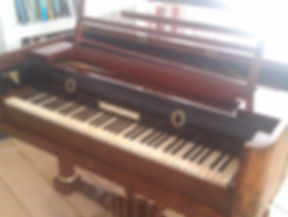
ARCHDUKE
ENSEMBLE
PROGRAMS

Master and Apprentice
The relationship between Master and Apprentice is one of great traditional importance, especially in music. Schumann served as a mentor for a whole generation of Romantic composers, while Fauré was a leading figure at the Paris Conservatoire from 1896-1920. The Romanian prodigy Enesco was one of his prize pupils.
Schumann Adagio and Allegro for horn and piano
Reinecke Horn Trio (or Brahms Horn Trio, op. 40)
Enesco Concertpiece for viola and piano
Fauré Piano Quartet in C minor op. 15

Beethoven's Horn
"Who is this Beethoven?” In May 1800 the Bohemian horn player Giovanni Punto performed the horn sonata opus 17 by Beethoven at a concert in Pest (Hungary), with the composer at the piano. One month earlier the same artists had given the premiere of the piece in Vienna, where Beethoven was getting more famous by the day; in Pest however, only 140 miles away from Vienna, Beethoven was virtually unknown. On the other hand, Punto was an international celebrity at the time. A gifted composer, he wrote more than 100 pieces for his instrument. In this program we present his lively Horn quartet next to Beethoven’s horn sonata, his sonorous string trio in C minor and his own arrangement for piano quartet of the quintet for piano and wind instruments.
Beethoven: string trio in C minor opus 9 no. 3
Beethoven: horn sonata opus 17
Giovanni Punto: quartet for horn and strings in F, opus 18 no. 1
Beethoven: piano quartet opus 16

Mr. and Mrs. Schumann
One of the most romantic pairings of the 19th century, and perhaps the first classical music "power couple", Robert and Clara Schumann were both highly influential composers. Clara was also a virtuoso pianist who was not only her husband's muse but the most important ambassador for his work. With this program we present some tender yet tempestuous sides of their relationship.
Märchenbilder, op. 113 voor altviool en piano (Mr.)
Piano Trio in G-klein op. 17 (Mrs.)
3 Romanzen op. 22 voor viool en piano (Mrs.)
Piano Kwartet in Es-groot, op. 47 (Mr., dedicated to Mrs.!)

Alla Zingarese!
The music of the Hungarian Roma, or 'gypsies', served as a point of inspiration for many composers over the centuries. The highlight of this thrilling program is the finale of Brahms's G minor piano quartet, the famous "Alla zingarese". The first half of the program features the temperamental music of three great Hungarian composers: Liszt, Bartók, and Dohnanyi.
Liszt: Hungarian Rhapsody No. 2 for solo piano
Bartók: Rhapsody No. 1 for violin and piano
Dohnanyi: String Trio, op. 9
Brahms: Piano Quartet in G minor, op. 25